This pub takes its name from its former use as the Union Bank of Scotland, the premises being listed grade A. Designed by David Bryce during 1874–1878, in a neo-classical style, these were later completed by his nephew John.
Framed photographs and text about David Octavius Hill and Robert Adamson.
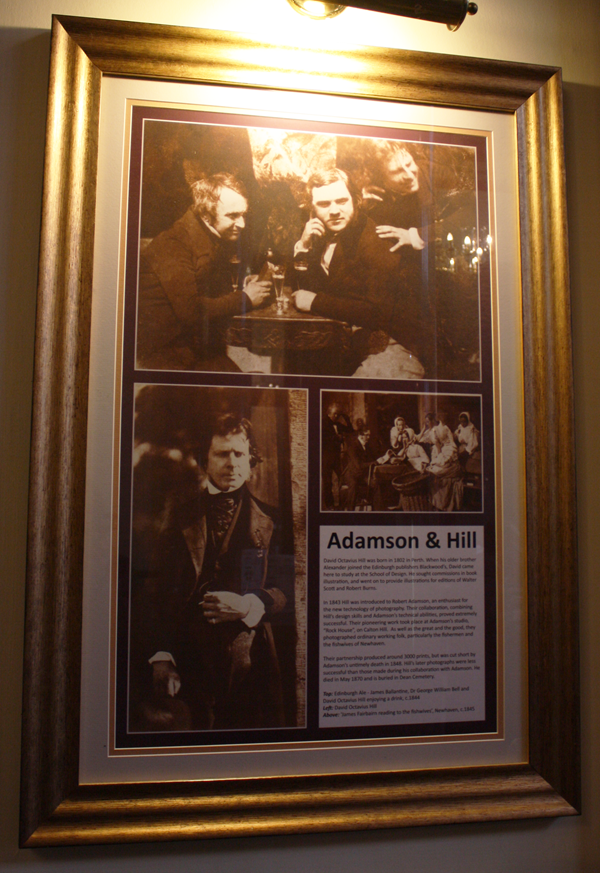
The text reads: David Octavius Hill was born in 1802 in Perth. When his older brother Alexander joined the Edinburgh publishers Blackwood’s, David came here to study at the School of Design. He sought commissions in book illustration, and went on to provide illustrations for editions of Walter Scott and Robert Burns.
In 1843 Hill was introduced to Robert Adamson, an enthusiast for the new technology of photography. Their collaboration, combining Hill’s design skills and Adamson’s technical abilities, proved extremely successful. Their pioneering work took place at Adamson’s studio, “Rock House”, on Carlton Hill. As well as the great and the good, they photographed ordinary working folk, particularly the fisherman and the fishwives of Newhaven.
Their partnership produced around 3000 prints, but was cut short by Adamson’s untimely death in 1848. Hill’s later photographs were less successful than those made during his collaboration with Adamson. He died in May 1870 and is buried in Dean cemetery.
Top: Edinburgh Ale – James Ballantine, Dr George William Bell and David Octavius Hill enjoying a drink, c.1844.
Left: David Octavius Hill
Above: ‘James Fairbairn reading to the fishwives’, Newham, c.1845.
Framed photographs and text about Sir Walter Scott, Robert Louis Stevenson and Alexander Graham Bell.
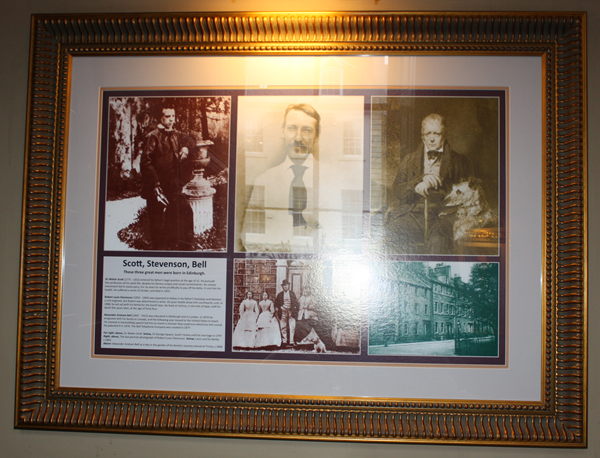
The text reads: Sir Walter Scott (1771 – 1832) entered his father’s legal practice at the age of 15. He pursued this profession all his adult life, despite his literary output and social commitments. An unwise investment led to bankruptcy. For six years he wrote prolifically to pay off his debts. It cost him his health. He suffered a series of strokes, and died in 1832.
Robert Louis Stevenson (1850 – 1894) was expected to follow in his father’s footsteps and become a civil engineer, but Robert was determined to write. His poor health drove him southwards until, in 1888, he set sail with his family for the South Seas. He lived at Vailima, in the hills of Apia, until his death five years later, at the age of forty-four.
Alexander Graham Bell (1847 – 1922) was educated in Edinburgh and in London. In 1870 he emigrated with his family to Canada, and the following year moved to the United States to teach. His interest in transmitting speech led him to invent a receiver that could turn electricity into sound. He patented it in 1876. The Bell Telephone company was created in 1877.
Far right: above, Sir Walter Scott, below, 25 George Square, Scott’s home until his marriage in 1797
Right: above, The last portrait photograph of Robert Louis Stevenson, below, Louis and his family, c.1865
Above: Alexander Graham Bell as a boy in the garden of his family’s country retreat at Trinity, c.1860.
Framed drawings and text about Henry Dundas.
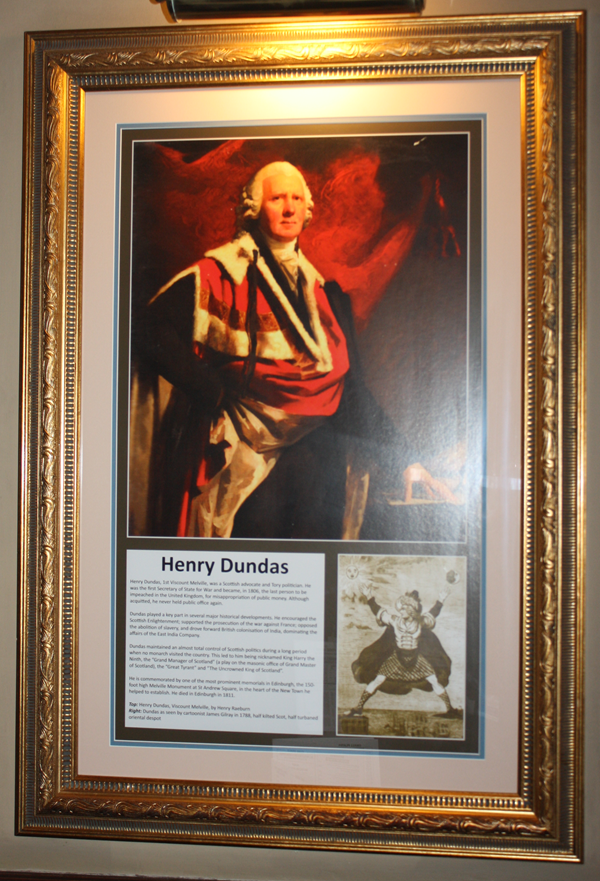
The text reads: Henry Dundas, 1st viscount Melville, was a Scottish advocate and Tory politician. He was the first Secretary of State for War and became, in 1806, the last person to be impeached in the United Kingdom, for misappropriation of public money. Although acquitted, he never held public office again.
Dundas played a key part in several major historical developments. He encouraged the Scottish Enlightenment; supported the prosecution of the war against France; opposed the abolition of slavery, and drove forward British colonisation of India, dominating the affairs of the East India Company.
Dundas maintained an almost total control of Scottish politics during a long period when no monarch visited the country. This led to him being nicknamed King Harry the Ninth, the “Grand Manager of Scotland” (a play on the masonic office of Grand Master of Scotland), the “Great Tyrant” and “The Uncrowned King of Scotland”.
He is commemorated by one of the most prominent memorials in Edinburgh, the 150-foot high Melville Monument at St Andrew Square, in the heart of the New Town he helped to establish. He died in Edinburgh in 1811.
Top: Henry Dundas, Viscount Melville, by Henry Raeburn
Right: Dundas as seen by cartoonist James Gilray in 1788, half kilted Scot, half turbaned oriental despot.
Framed photographs, drawings and text about Chubb safes.
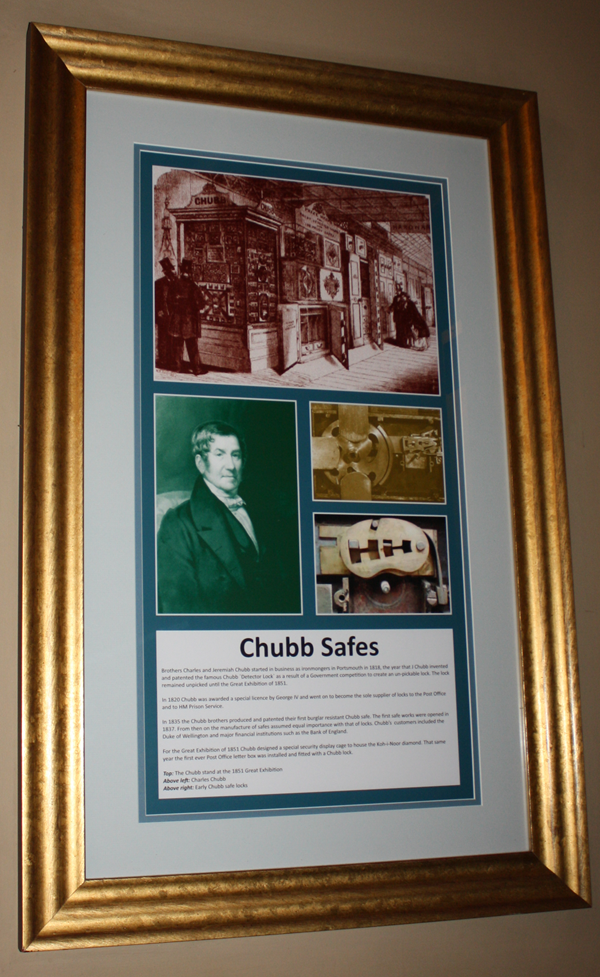
The text reads: Brother Charles and Jeremiah Chubb started in business as ironmongers in Portsmouth in 1818, the year that J. Chubb invented and patented the famous Chubb ‘Detector Lock’ as a result of a Government competition to create an un-pickable lock. The lock remained unpicked until the Great Exhibition of 1851.
In 1820 Chubb was awarded a special licence by George IV and went on to become the sole supplier of locks to the Post Office and to HM Prison Service.
In 1835 the Chubb brothers produced and patented their first burglar resistant Chubb safe. The first safe works were opened in 1837. From then on the manufacture of safes assumed equal importance with that of locks. Chubb’s customers included the Duke of Wellington and major financial institutions such as the Bank of England.
For the Great Exhibition of 1851 Chubb designed a special security display cage to house the Koh-i-Noor diamond. That same year the first ever Post Office letter box was installed and fitted with a Chubb lock.
Top: The Chubb stand at the 1851 Great Exhibition
Above left: Charles Chubb
Above right: Early Chubb safe locks.
Framed drawings and text about James Craig.
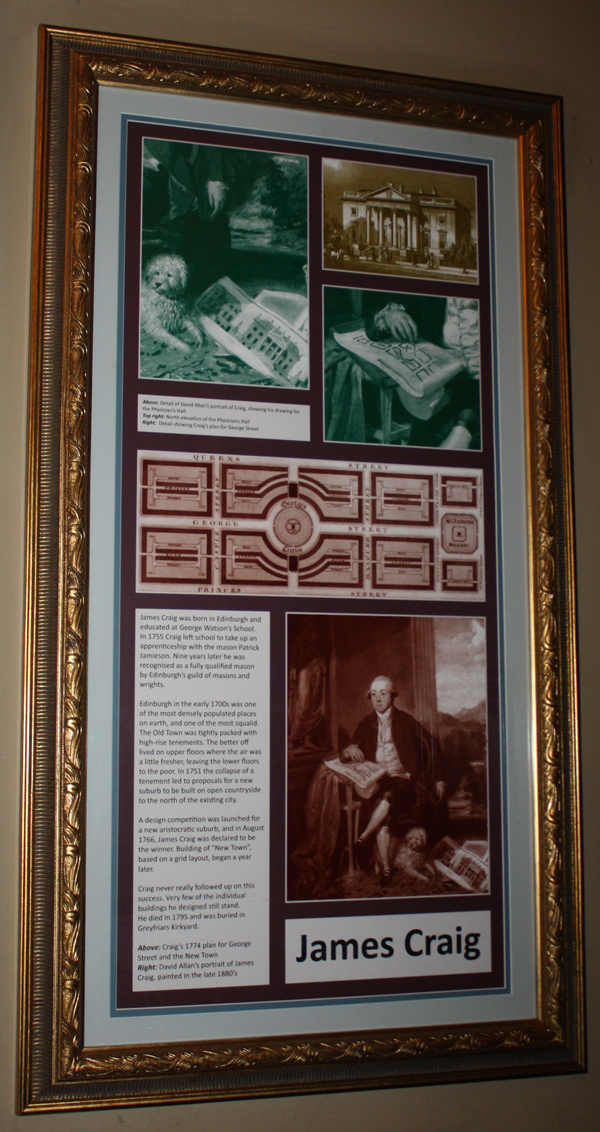
The text reads: James Craig was born in Edinburgh and educated at George Watson’s School. In 1755 Craig left school to take up an apprenticeship with the mason Patrick Jamieson. Nine years later he was recognised as a fully qualified mason by Edinburgh’s guild of masons and wrights.
Edinburgh in the early 1700s was one of the most densely populated places on earth, and one of the most squalid. The Old Town was tightly packed with high –rise tenements. The better off lived on upper floors where the air was a little fresher, leaving the lower floors to the poor. In 1751 the collapse of a tenement led to proposals for a new suburb to be built on open countryside to the north of the existing city.
A design competition was launched for a new aristocratic suburb, and in August 1766, James Craig was declared to be the winner. Building of “New Town”, based on a grid layout, began a year later.
Craig never really followed up on this success. Very few of the individual buildings he designed still stand. He died in 1795 and was buried in Greyfriars Kirkyard.
Above: Detail of David Allan’s portrait of Craig, showing his drawing for the Physician’s Hall Top right: North elevation of the Physicians Hall Right: Detail showing Craig’s plan for George Street
Above: Craig’s 1774 plan for George Street and the New Town
Right: David Allan’s portrait of James Craig, painted in the late 1880’s.
Framed prints and text about Sir Henry Raeburn.
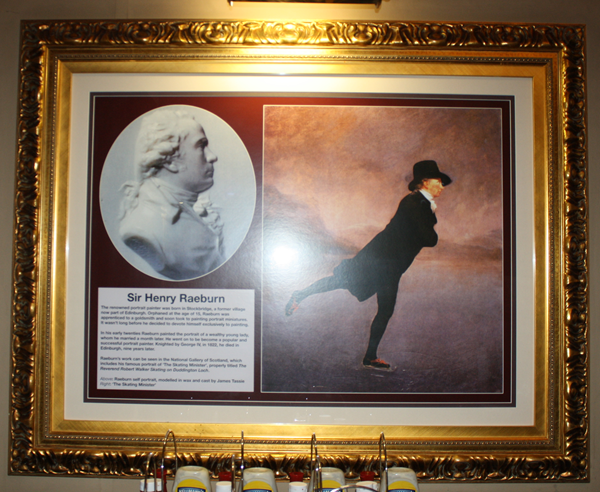
The text reads: The renowned portrait painter was born in Stockbridge, a former village now part of Edinburgh. Orphaned at the age of 15, Raeburn was apprenticed to a goldsmith and soon took to painting portrait miniatures. It wasn’t long before he decided to devote himself exclusively to painting.
In his early twenties Raeburn painted the portrait of a wealthy young lady, whom he married a month later. He went on to become a popular and successful portrait painter. Knighted by George IV, in 1822, he died in Edinburgh, nine years later.
Raeburn’s work can be seen in the National Gallery of Scotland, which includes his famous portrait of ‘The Skating Minister’, properly titled The Reverend Robert Walker Skating on Duddington Loch.
Above: Raeburn self portrait, modelled in wax and cast by James Tassie
Right: ‘The Skating Minister’.
Framed prints and text about the House of Hanover.
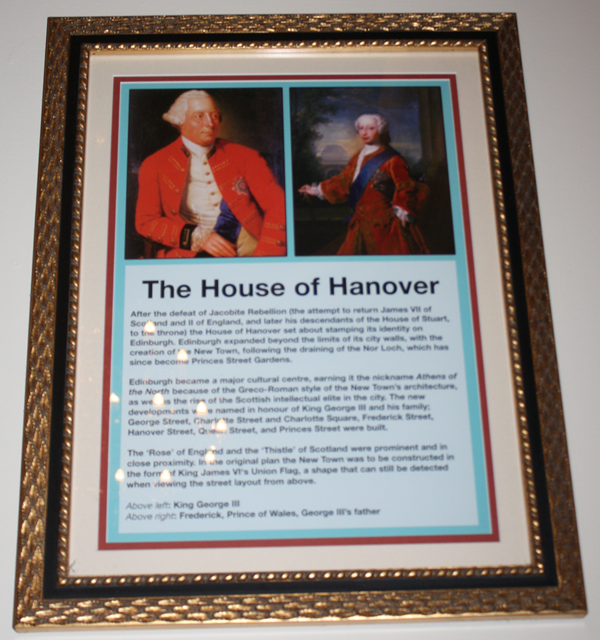
The text reads: After the defeat of Jacobite Rebellion (the attempt to return James VII of Scotland and II of England, and later his descendants of the House of Stuart, to the throne) the House of Hanover set about stamping its identity on Edinburgh. Edinburgh expanded beyond the limits of its city walls, with the creation of the New Town, following the draining of the Nor Loch, which has since become Princes Street Gardens.
Edinburgh became a major cultural centre, earning it the nickname Athens of the North because of the Greco-Roman style of the New Town’s architecture, as the rise of the Scottish intellectual elite in the city. The new developments were named in honour of King George III and his family; George Street, Charlotte Street and Charlotte Square, Frederick Street, Hanover Street, Queen Street, and Princes Street were built.
The ‘Rose’ of England and the ‘Thistle’ of Scotland were prominent and in close proximity. In the original plan the New Town was to be constructed in the form of King James VI’s Union Flag, a shape that can still be detected when viewing the street layout from above.
Above left: King George III
Above right: Frederick, Prince of Wales, George III’s father.
A framed portrait and text about Robert Burns.
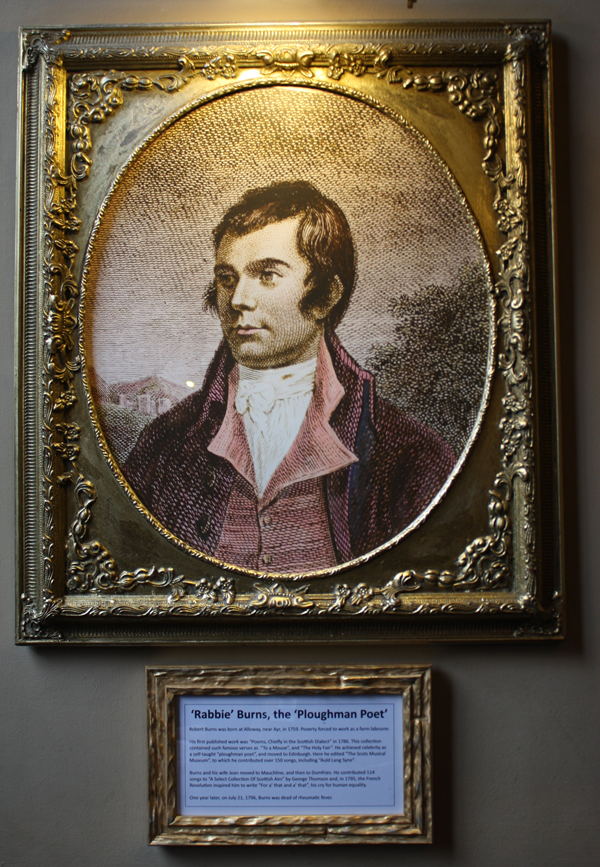
The text reads: Robert Burns was born at Alloway, near Ayr, in 1759. Poverty forced to work as a farm labourer.
His first published work was “Poems, Chiefly in the Scottish Dialect” in 1786. This collection contained such famous verses as “To a Mouse”, and “The Holy Fair”. He achieved celebrity as a self-taught “ploughman poet”, and moved to Edinburgh. Here he edited “The Scots Musical Museum”, to which he contributed over 150 songs, including “Auld Land Syne”.
Burns and his wife Jean moved to Mauchline, and then to Dumfries. He contributed 114 sons to “A Select Collection Of Scottish Airs” by George Thompson and, in 1795, the French Revolution inspired him to write “For a’ that and a’ that”, his cry for human equality.
One year later, on July 21, 1796, Burns was dead of rheumatic fever.
A framed drawing of The Bank of Scotland Building, in George Street of 1876 – along with text.
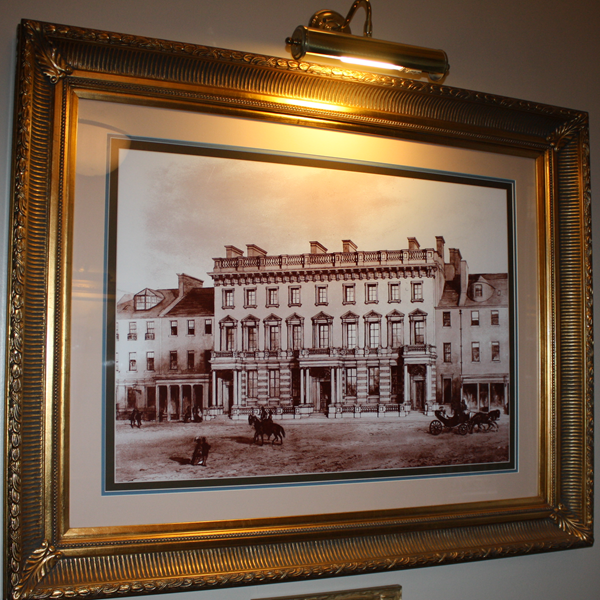
The text reads: The Bank of Scotland building at 62-66 George Street was designed by David Bryce in 1874 as the Edinburgh head office of the Glasgow-based Union Bank. It was finished after his death in May 1876 by his nephew, John Bryce. The bank’s long front has three Ionic porches on the ground floor, Corinthian detail on the first floor, and a panelled and bracketed cornice. David Bryce (1803-76) also transformed the head office of the Bank of Scotland on the Mound in 1864 to match its imposing site.
A framed drawing of The Assembly Rooms, George Street, in 1829.
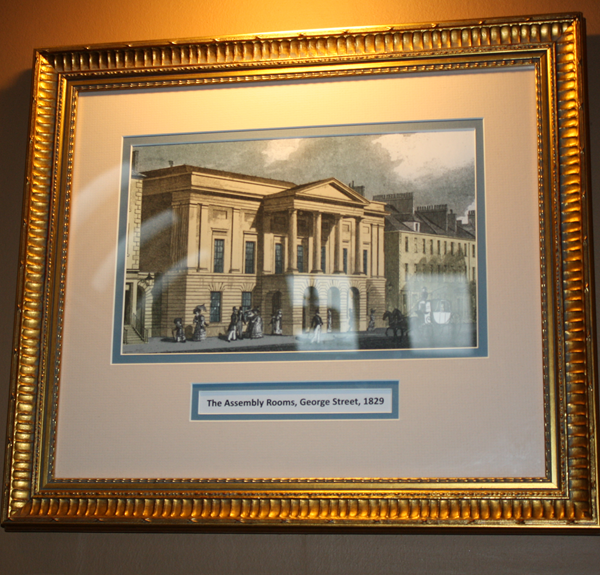
A framed portrait of Sir Walter Scott, in 1808.
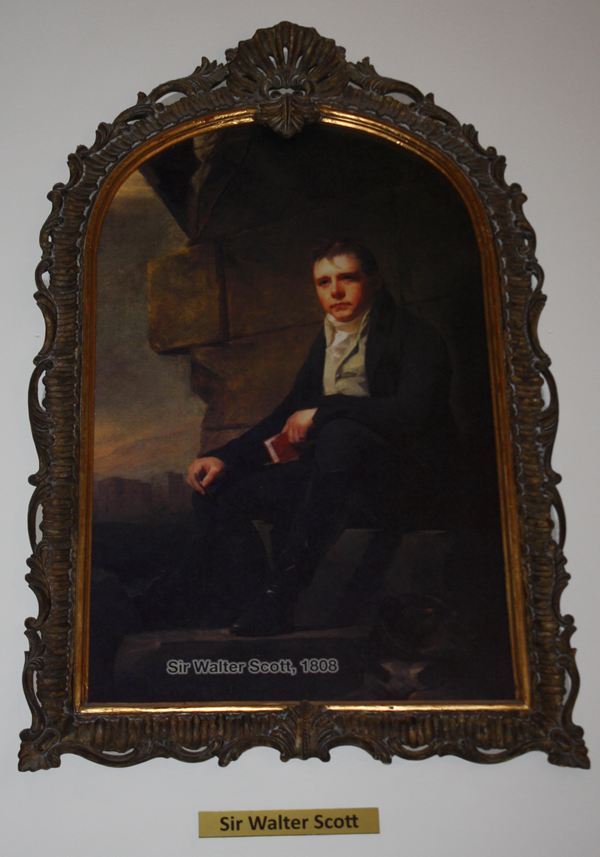
A framed portrait of Thomas Telford.
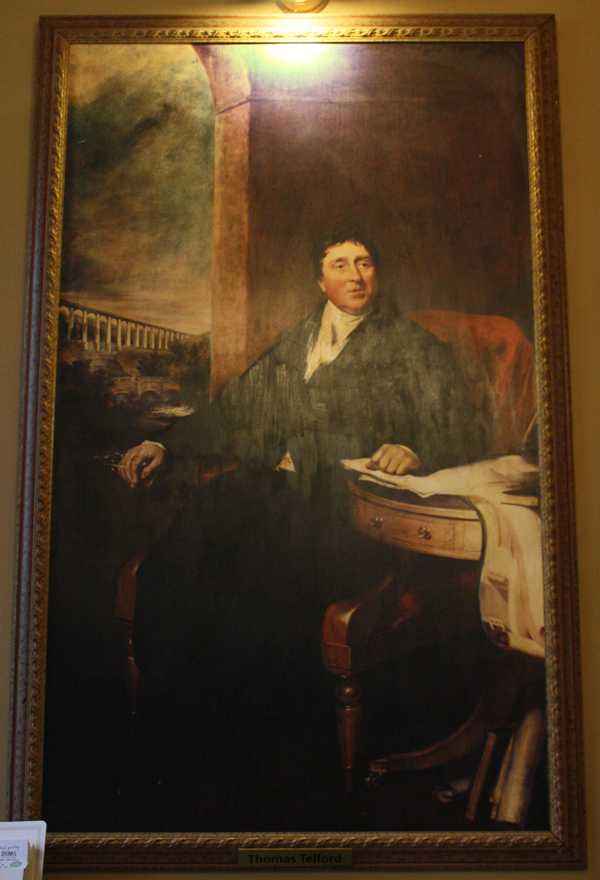
A framed portrait of James Craig.
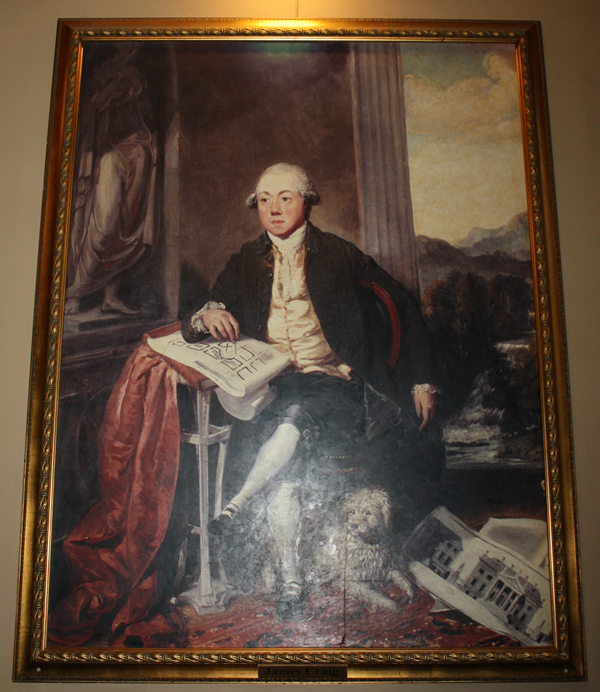
A framed portrait of Henry Dundas.
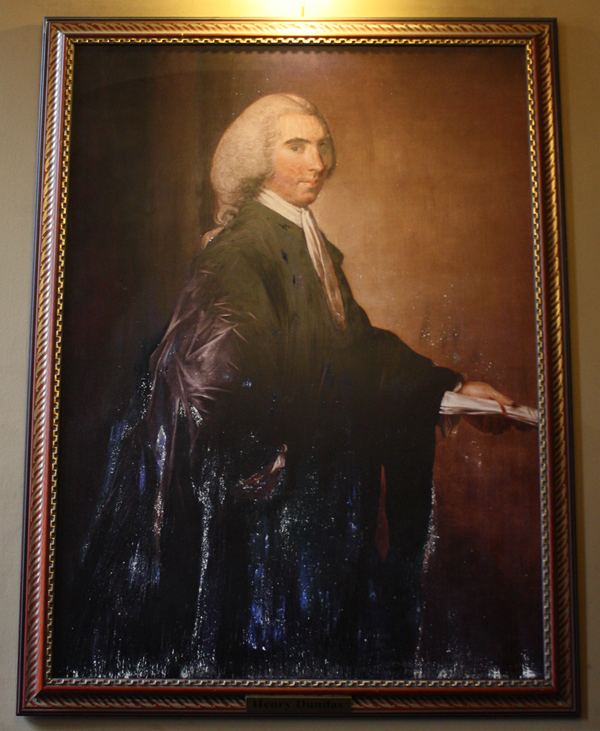
A framed portrait of Sir Walter Scott.
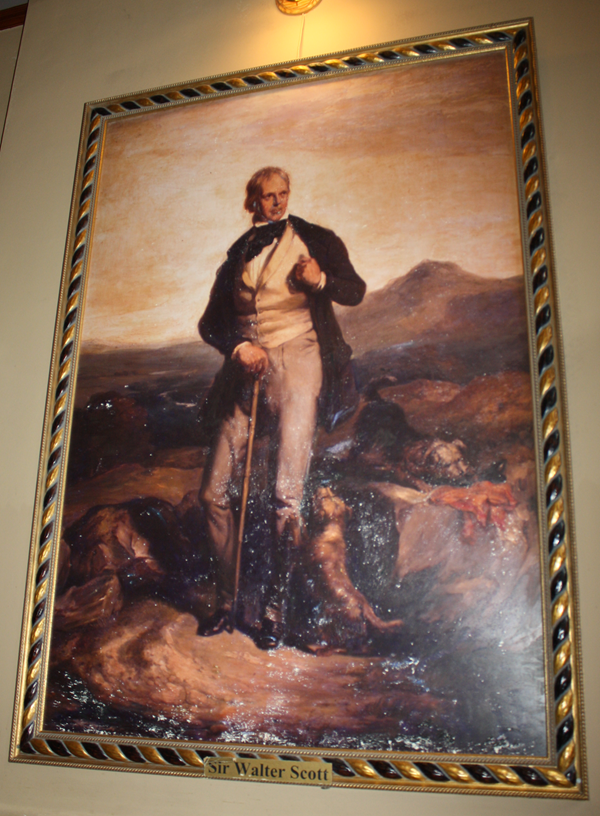
A sculpture entitled Money, Money, Money…
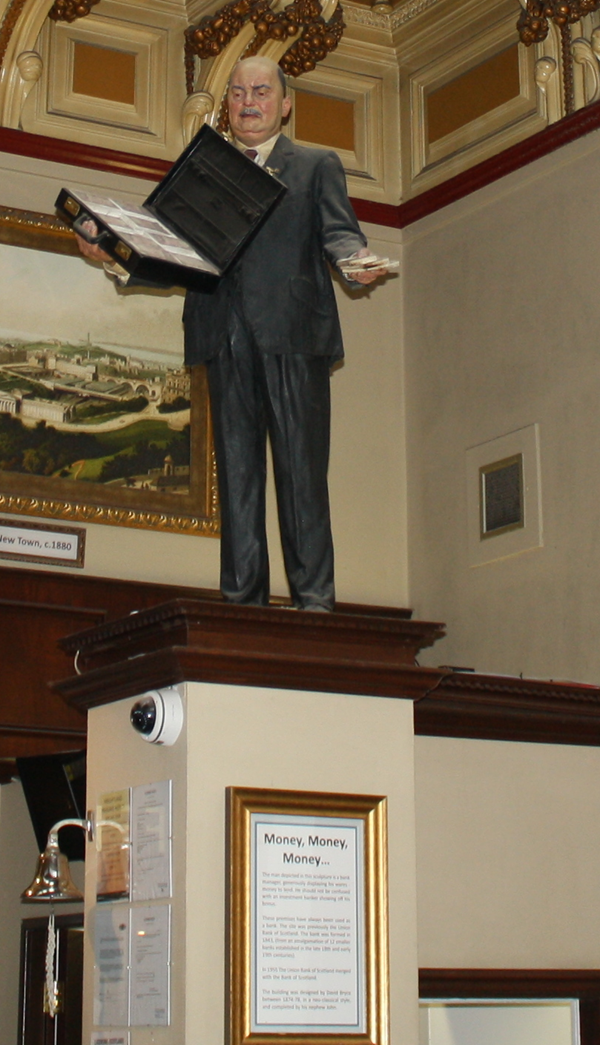
The text reads: The man depicted in this sculpture is a bank manager, generously displaying his wares – money to lend. He should not be confused with an investment banker showing off his bonus.
These premises have always been used as a bank. The site was previously the Union Bank of Scotland. The bank was formed in 1843, (from an amalgamation of 12 smaller banks established in the late 18th and early 19th centuries).
In 1955 The Union Bank of Scotland merged with the Bank of Scotland.
The building was designed by David Bryce between 1874-78, in a neo-classical style, and completed by his nephew John.
An original Chubb vault, in one of the main dining areas of the pub.
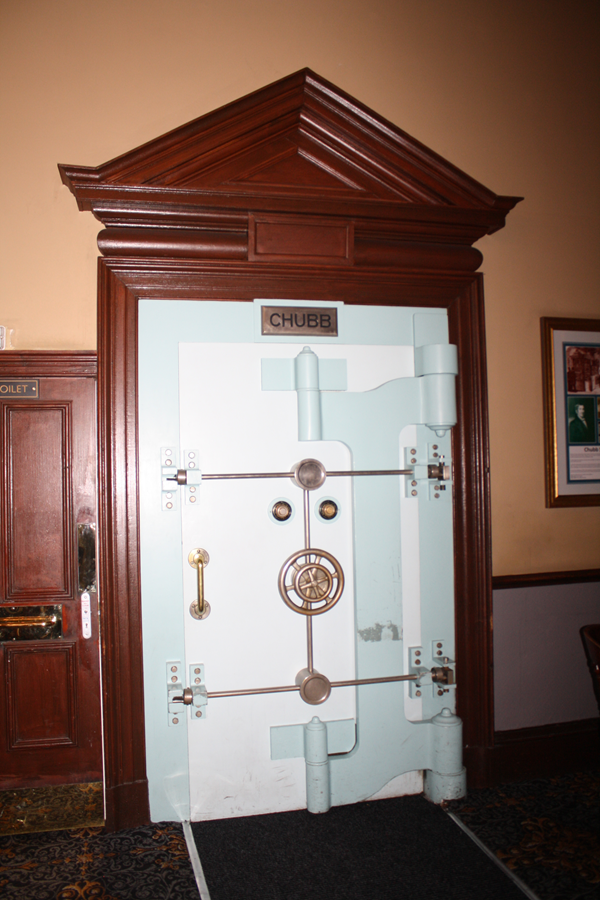
The back of the vault door, showing the locking mechanism.
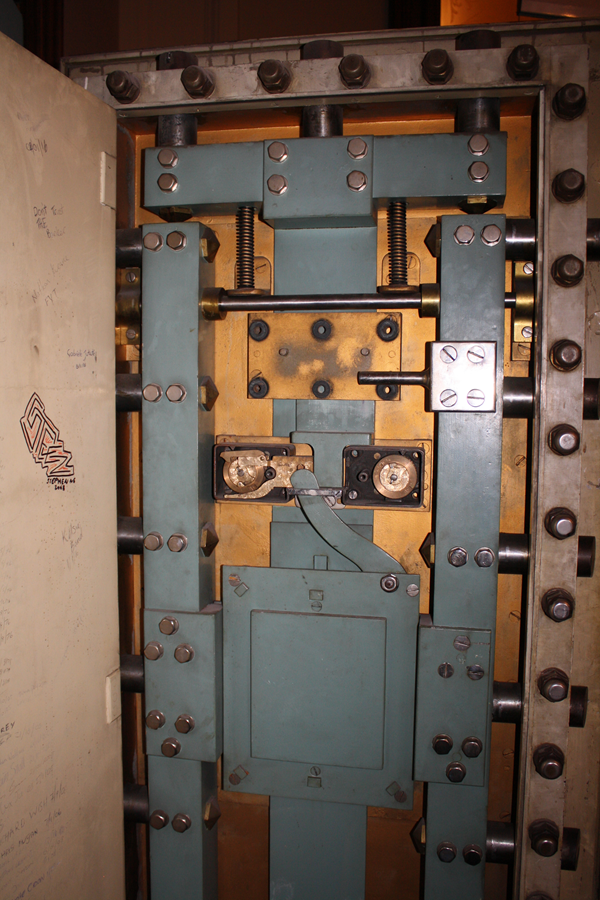
Markings inside the vault date from 5 February 1968.
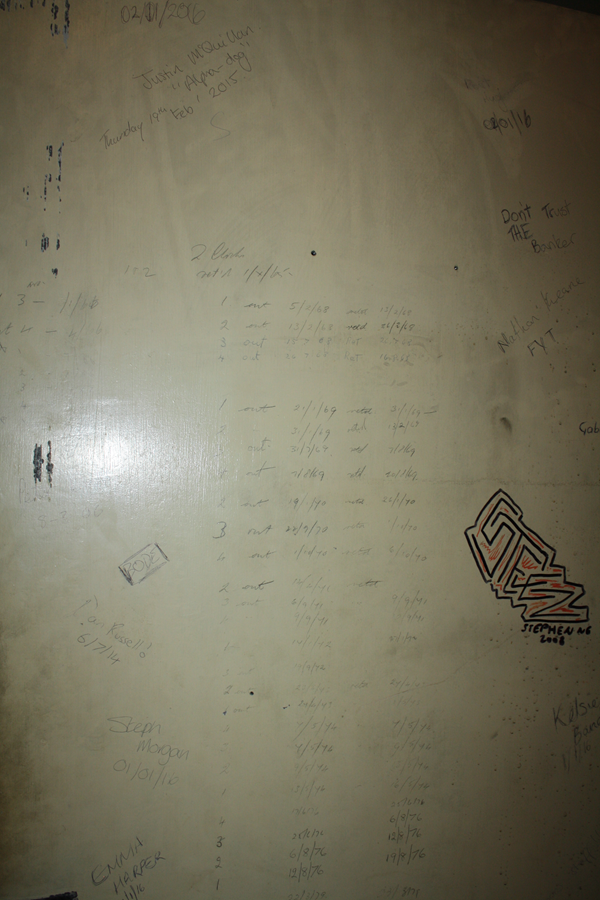
Another original Chubb vault inside the pub, this time a much smaller version.
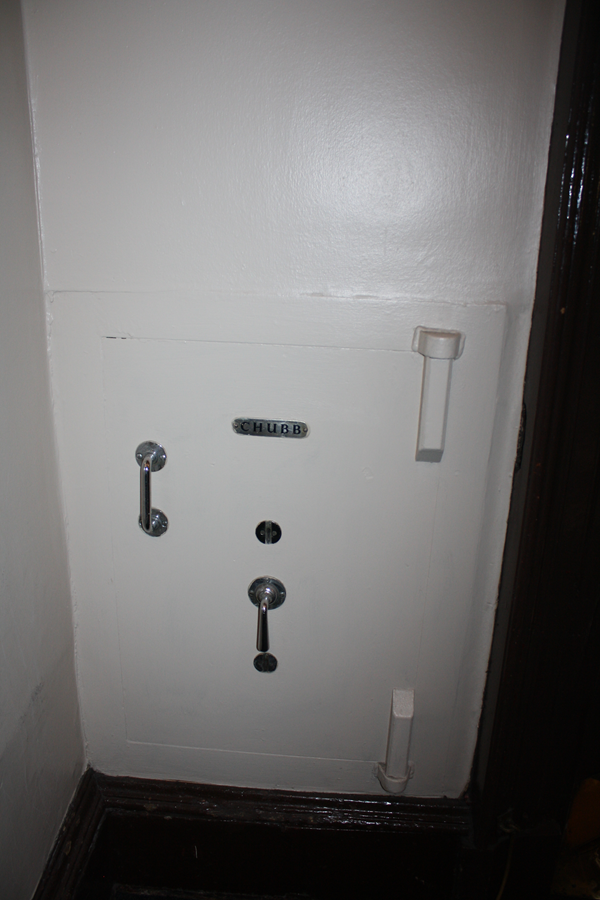
An original doorbell on the front of the pub, now out of use.
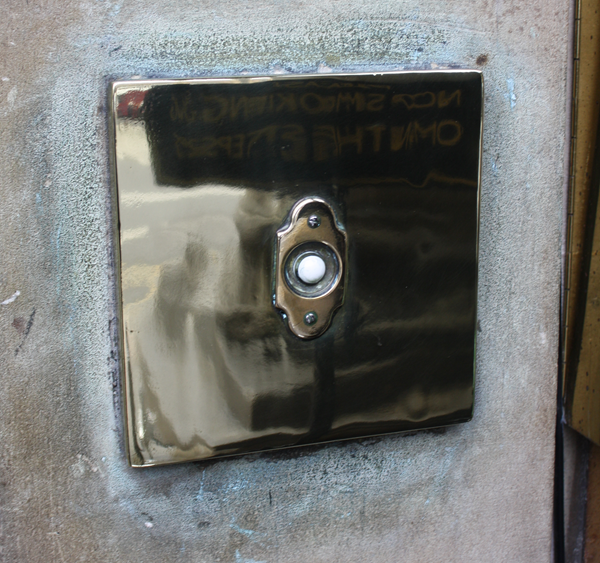
A framed painting entitled Cycat by the Sea, by Helga Chart.
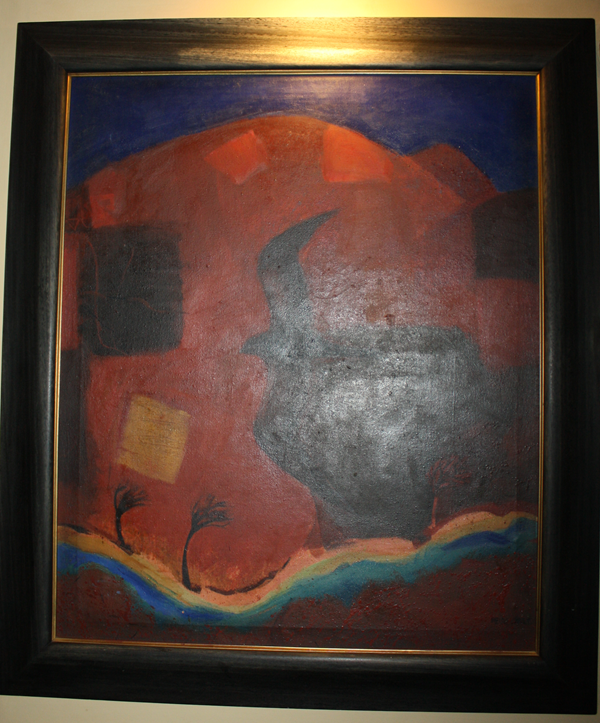
The text reads: Helga Chart was born 1926, and trained at Edinburgh College of Art from 1962 until 1967. She lectured in Art and Design until taking up painting full time.
She has served as Vice President of both Visual Arts Scotland and the Royal Scottish Society of Painters in Watercolours. Her work is held in many public and private collections in the UK and abroad.
Internal photographs of the pub, showing the impressive original layout.
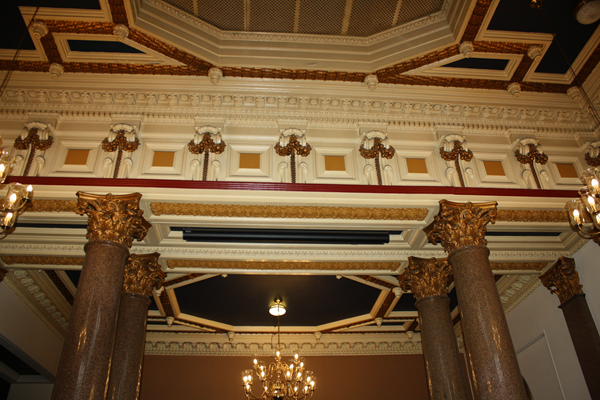
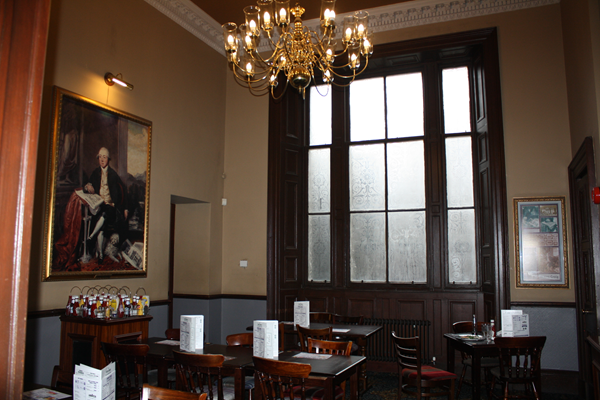
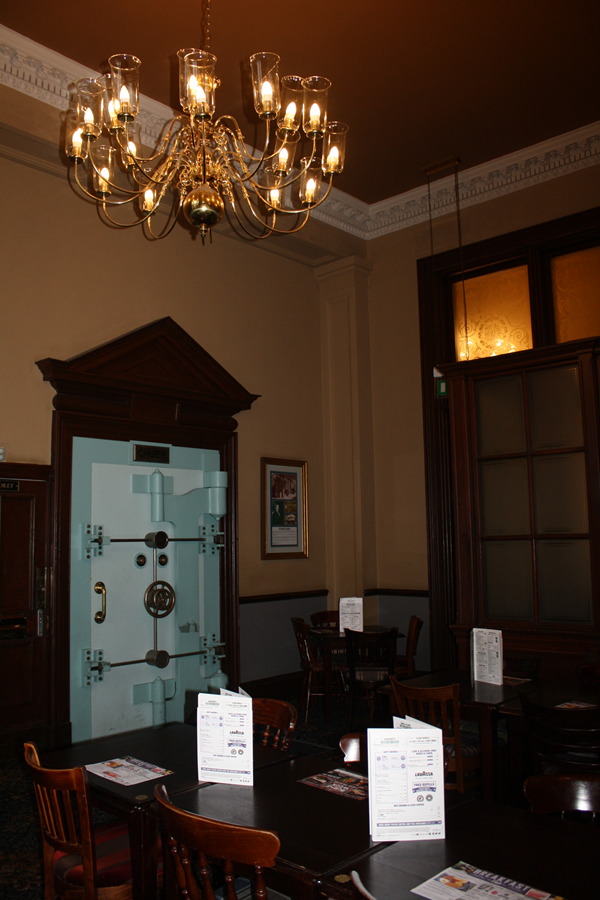
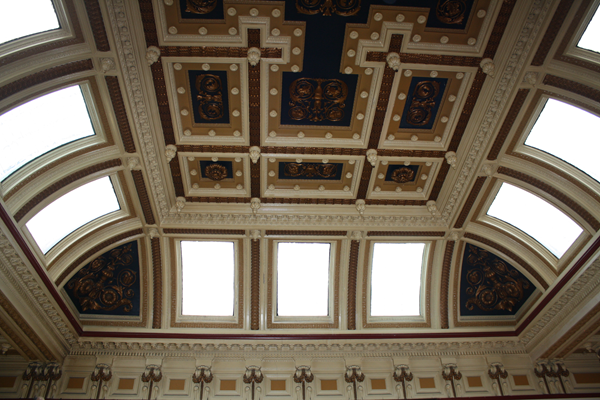
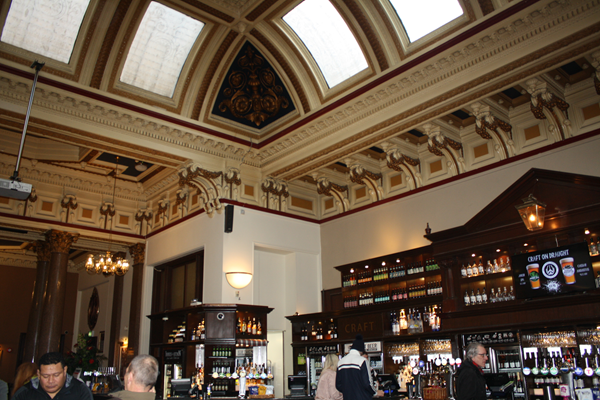
External photograph of the building – main entrance.
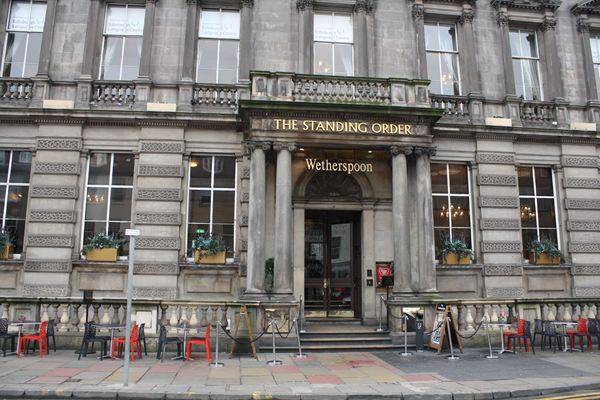
If you have information on the history of this pub, then we’d like you to share it with us. Please e-mail all information to: pubhistories@jdwetherspoon.co.uk